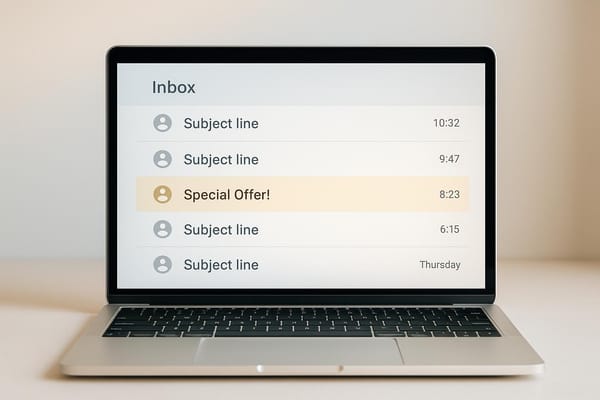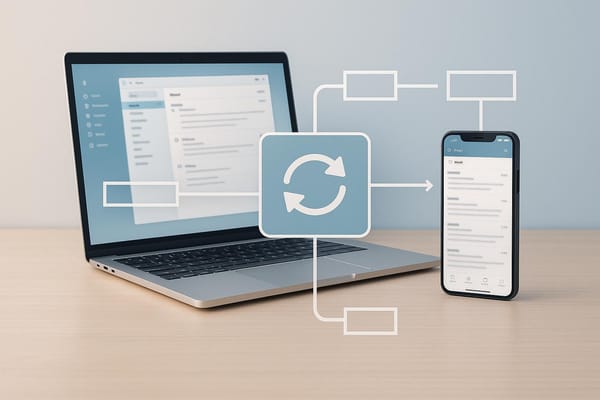Cold Email Metrics vs. Deliverability Metrics
Explore the critical balance between cold email performance and deliverability metrics to enhance your outreach success in 2025.

Cold email success hinges on two key factors: performance and deliverability. Performance metrics like open, reply, and conversion rates show how recipients engage with your emails. Deliverability metrics, such as inbox placement and bounce rates, ensure your emails actually reach those recipients.
Here’s the catch: even the best-performing email won’t matter if it’s flagged as spam. In 2025, with open rates averaging 27.7% and reply rates at just 5.1%, balancing these metrics is more critical than ever.
Key Takeaways:
- Performance Metrics: Open rates (40–60%), reply rates (1–3%), and conversion rates (<1%) measure engagement.
- Deliverability Metrics: Healthy inbox placement (>95%) and low bounce rates (<5%) ensure emails reach inboxes.
- Interdependence: Poor deliverability can ruin even the most engaging campaigns.
- Action Steps: Focus on technical setup (SPF, DKIM, DMARC), clean email lists, and personalized content.
Bottom Line: Deliverability sets the foundation; performance measures success. Both are essential for effective cold email campaigns.
Does Cold Email Open Tracking Negatively Affect Deliverability?
Cold Email Performance Metrics
Cold email performance metrics are essential for understanding how well your outreach efforts are connecting with recipients. By analyzing these metrics, you can make smarter decisions to improve engagement and achieve better outcomes.
Open Rate
Open rate tracks the percentage of recipients who open your email, usually measured through an invisible tracking pixel that loads when the email is viewed. For B2B campaigns in the U.S., a strong open rate typically exceeds 60%, with top campaigns reaching between 70% and 88%.
However, privacy tools like Apple's Mail Privacy Protection and image-blocking features in email clients can distort these numbers. For example, Apple's privacy features or corporate security systems may trigger false opens or block the tracking pixel entirely. This means that even if your campaign shows an 80% open rate, the actual number of people reading the email could be much lower.
Given these limitations, many marketers now view open rates as a general indicator rather than a precise measure of engagement. Still, a sudden drop or persistently low open rates could signal issues with deliverability, weak subject lines, or a damaged sender reputation.
Reply Rate and Conversion Metrics
Reply rate measures the percentage of recipients who respond to your email, whether positively or negatively. For cold email campaigns, reply rates typically range from 1% to 5%, with 1% to 3% being common for B2B outreach. Current averages hover around 5.1%.
A reply - whether it's a positive inquiry or a negative rejection - provides valuable feedback about your messaging and targeting. Positive replies might include requests for more information or invitations to discuss further, while negative ones, such as unsubscribe requests, highlight areas for improvement.
Conversion rate, on the other hand, tracks the percentage of recipients who take a specific action, like scheduling a meeting, signing up for a demo, or making a purchase. These rates are typically lower than reply rates, often falling below 1%, though they can vary depending on industry and campaign quality. Since conversions directly impact revenue, they are considered the ultimate measure of success.
Unlike open or click metrics, replies and conversions require intentional actions from recipients, making them a more reliable indicator of genuine engagement.
Click-Through Rate
Click-through rate (CTR) measures the percentage of recipients who click on links in your email. While this metric can help gauge interest in specific offers or content, it has its limitations. Automated security tools, such as link scanners, often check URLs for safety, artificially inflating CTR. For instance, a campaign showing a 15% CTR might only have 2–3% of those clicks coming from actual humans.
Because of these challenges, CTR works best as a secondary engagement metric rather than a primary one. It can still offer useful insights when paired with other data points.
Bringing It All Together
By analyzing these metrics together, you can uncover patterns that highlight areas for improvement. For example, high open rates but low reply or conversion rates might suggest that your subject lines are working, but the email content needs refinement. On the flip side, low open rates paired with strong reply rates could indicate deliverability issues affecting a portion of your email list. When used collectively, these metrics provide a clearer picture of your campaign's strengths and weaknesses, helping you fine-tune your outreach strategy.
Deliverability Metrics: Getting Emails to the Inbox
Performance metrics tell you how well your audience engages with your emails, but deliverability metrics are what ensure those emails actually make it to the inbox. If your emails are bouncing back or heading straight to spam, even the most well-crafted campaigns won’t get the attention they deserve.
Deliverability is the backbone of any email outreach strategy. Without it, open and reply rates are meaningless. Monitoring these metrics is essential to ensure your efforts don’t go to waste.
Inbox Placement and Bounce Rates
Inbox placement rate tracks the percentage of emails that make it to the recipient's primary inbox rather than getting flagged as spam or sent to promotional folders. For cold email campaigns in 2025, a healthy inbox placement rate is above 95%. Falling below this threshold can significantly impact your campaign's success. Think of it this way: if your placement rate dips under 95%, you’re essentially losing one out of every twenty potential connections before they even see your message.
On the other hand, bounce rate measures the percentage of emails that fail to deliver. These failures can be due to invalid email addresses (hard bounces) or temporary issues like full inboxes or server problems (soft bounces). Industry standards suggest keeping bounce rates below 5%, but the average currently hovers around 7.5%. A high bounce rate doesn’t just hinder your current campaign - it can damage your sender reputation, making future emails more likely to be flagged as spam.
For example, a B2B SaaS company saw their bounce rate spike above 10% because of outdated lead lists. This hurt their sender reputation, and their inbox placement dropped below 80%, with most emails ending up in spam folders. After cleaning their list and implementing proper technical authentication, their bounce rate fell below 2%, and inbox placement rebounded to over 95%.
Next, let’s look at how spam complaints and unsubscribes can further influence your sender reputation.
Spam Complaint and Unsubscribe Rates
Spam complaint rate measures how often recipients mark your emails as spam, while unsubscribe rate reflects how many people opt out of receiving future emails. Spam complaints are particularly damaging - rates above 0.1% can harm your sender reputation. These complaints signal to email providers that your messages are unwanted, increasing the likelihood that future emails will be routed to spam folders.
Unsubscribe rates for cold email campaigns average around 2.17%. While unsubscribes are a natural part of email outreach, sudden spikes can indicate problems with your targeting, messaging, or frequency. Unlike spam complaints, moderate unsubscribe rates don’t directly harm deliverability, but they can highlight areas for improvement. Think of unsubscribes as feedback - they show who isn’t interested - while spam complaints suggest a more serious issue, like being flagged as irrelevant or intrusive.
Now, let’s dive into how technical setup plays a key role in ensuring high deliverability.
DNS Health and Infrastructure Setup
A strong technical foundation is essential for maintaining high inbox placement. SPF (Sender Policy Framework), DKIM (DomainKeys Identified Mail), and DMARC (Domain-based Message Authentication, Reporting & Conformance) work together to verify that you’re a legitimate sender and protect against email spoofing. In 2025, properly configured DMARC policies are a must for cold outreach. These protocols authenticate your identity, reducing the chances of your emails being flagged as spam.
Older domains and gradual IP warming also contribute to better deliverability. Platforms like Icemail.ai make this technical setup easier by automating complex processes such as DNS configuration.
"Icemail.ai has transformed how I manage my email infrastructure. The automated setup for Google Workspace accounts, including DKIM, SPF, and DMARC configuration, saved me hours of work."
- Suprava Sabat, @AcquisitionX
Icemail.ai streamlines these processes with features like 1‑click import/export, automated DNS setup, and scalable management. Their plans include automated DKIM, SPF, and DMARC setup, ensuring a 99.2% inbox delivery rate. For $2.50/month per Google Workspace mailbox or $3.00/month per Microsoft mailbox, users get comprehensive DNS management and real-time mailbox creation. For teams managing multiple domains or running large-scale campaigns, this level of automation not only saves time but also ensures consistent deliverability, allowing you to focus on crafting effective campaigns.
Cold Email Metrics vs. Deliverability Metrics: Side-by-Side Comparison
This section dives into the relationship between cold email performance metrics and deliverability metrics, highlighting their interdependence. Without proper inbox placement, engagement metrics lose their value entirely.
Comparison Table
Performance metrics focus on recipient interaction, while deliverability metrics ensure emails successfully reach their intended inboxes.
| Metric Type | Example Metrics | Purpose | Benchmark | Impact on Success |
|---|---|---|---|---|
| Performance | Open Rate | Tracks initial engagement | 40-60% | Reflects the effectiveness of the subject line |
| Performance | Reply Rate | Measures recipient responses | 1-3% | Indicates the relevance of your message |
| Performance | Click-Through Rate | Evaluates CTA effectiveness | 2-5% | Shows how appealing your call-to-action is |
| Deliverability | Inbox Placement | Measures emails landing in primary inbox | >85% | A prerequisite for any engagement |
| Deliverability | Bounce Rate | Percentage of undelivered emails | <2% | High rates hurt sender reputation |
| Deliverability | Spam Complaint | Emails marked as spam | <0.1% | High rates risk blacklisting |
| Deliverability | DNS Health | Validates SPF/DKIM/DMARC setup | 100% valid | Builds technical trust with email providers |
The bottom line? Deliverability metrics take precedence. If your emails aren’t landing in inboxes, even a stellar open rate won’t matter.
Common Mistakes
Misunderstanding these metrics often leads to wasted efforts and missed opportunities. For example, many teams celebrate high open rates without checking inbox placement. However, tools like Apple Mail Privacy Protection or security scanners can artificially inflate open rates, creating a false sense of success .
Another frequent misstep is ignoring bounce and spam rates while focusing on reply rates. A B2B SaaS company, for instance, saw its reply rate plummet from 2% to 0.5% over three months as its bounce rate surged past 10%. The culprit? A neglected email list and misconfigured DNS records. Once the list was cleaned and DNS settings corrected, the reply rate rebounded to 2% - without changing a single word of the email content.
Low reply rates are often tied to deliverability issues, not poor messaging. Even the most persuasive email copy won’t generate responses if it lands in spam folders. That’s why setting up SPF, DKIM, and DMARC records correctly is non-negotiable.
Another common pitfall is overlooking sender reputation. For instance, inflated click rates may be caused by automated scanners, not real user engagement. When click rates are high but conversions are low, teams sometimes blame landing pages instead of recognizing that automated systems might be interacting with their emails.
The solution? Always cross-check performance drops with deliverability data. If open rates take a sudden dip, check inbox placement first. Similarly, if reply rates remain stubbornly low, review bounce and spam complaint rates before assuming your email content is the problem. This approach ensures you can pinpoint whether the issue lies in technical setup or messaging.
Avoiding these common mistakes is essential for aligning both performance and deliverability metrics, ensuring your outreach campaigns are effective from start to finish.
Impact on Outreach Strategy and Tools
Understanding performance and deliverability metrics can revolutionize how US-based teams scale their outreach efforts. By integrating these metrics into their strategies, teams can create campaigns that are not only efficient but also compliant and cost-effective. This involves a combination of technical setup and thoughtful engagement optimization. Below, we’ll outline some actionable best practices to help improve these metrics even further.
Best Practices for Metric Improvement
Start with the technical groundwork - SPF, DKIM, and DMARC configurations are non-negotiable. Many teams rush into A/B testing subject lines, only to find their emails landing in spam folders. Before diving into engagement tactics, ensure your DNS setup is solid. Without correctly configured SPF, DKIM, and DMARC records, even the best content won’t make it to the inbox.
Warm up new domains and IPs gradually. Begin by sending just 10–20 emails daily, then slowly increase the volume over several weeks. Start with contacts who are likely to engage, such as colleagues or trusted partners. Positive initial interactions help build a strong sender reputation and avoid spam filters.
Track metrics on different schedules. Deliverability metrics, like bounce rates, spam complaints, and inbox placement, should be monitored daily to catch any technical issues early. Engagement metrics, such as reply and click-through rates, can be reviewed weekly to spot trends in content performance. Monthly analysis of conversion rates and ROI can help guide long-term strategy.
Prioritize list quality over list size. A smaller, high-quality list will always outperform a large, unverified one. Use double-verification to ensure email addresses are valid, and avoid "Accept All" addresses that can skew bounce rates. Regularly clean your lists by removing unengaged contacts after 30–60 days to maintain strong engagement metrics.
Go beyond basic personalization. Adding a recipient’s first name is a start, but true personalization involves referencing specific company challenges, recent news, or even mutual connections. This approach not only improves reply rates but also reduces the likelihood of being marked as spam.
Segment campaigns for better targeting. For US-based outreach, segmenting by geography, industry, or company size can make a big difference. For example, tailoring emails by time zone or industry can increase reply rates by as much as 30%, all while keeping unsubscribe rates low.
By regularly reviewing both engagement and deliverability metrics, teams can stay ahead of potential issues and adapt their strategies accordingly.
Icemail.ai for Scalable Deliverability Solutions

Scaling outreach while maintaining strong deliverability can be challenging, but platforms like Icemail.ai make it easier. For US teams, this tool simplifies technical tasks and enables more time to focus on engaging prospects.
Automated DNS management saves hours. Icemail.ai handles DNS setup in minutes, ensuring proper authentication from the start for just $2.
Pre-warmed mailboxes eliminate the wait. Instead of spending weeks warming up new domains, Icemail.ai provides mailboxes with established reputations for $5/month. These pre-warmed accounts help you hit the ground running.
US-based IP addresses improve inbox placement. For teams targeting American prospects, using US-based IPs enhances sender trust and boosts inbox placement rates.
Fast deployment for time-sensitive campaigns. With mailboxes ready to send in just 30 minutes and a quick 10-minute onboarding process, Icemail.ai supports aggressive scaling timelines.
Flexible pricing for all budgets. Options include Google Admin Mailboxes at $2.50/month, Microsoft Mailboxes at $3/month, and basic IMAP/SMTP plans starting at just $0.50/month. This flexibility allows teams to align infrastructure costs with their campaign budgets while maintaining high deliverability standards.
Proven results backed by strong reviews. Icemail.ai boasts a 99.2% inbox delivery rate, helping ensure your emails land in primary inboxes. This translates to higher open rates, better reply rates, and improved conversions - all without requiring changes to your content.
Conclusion: Balancing Metrics for Cold Email Success
Achieving cold email success means finding the right balance between performance and deliverability metrics. With open rates dropping to 27.7% and reply rates dipping to just 5.1% in 2025, this balanced approach is no longer optional - it's essential for effective outreach.
These metrics are deeply interconnected. High reply rates won’t matter if your emails bounce due to poor DNS configuration. Similarly, a 99% delivery rate won’t drive results if your message fails to connect with recipients. The best-performing teams in the U.S. recognize this: strong deliverability creates the foundation, while performance metrics measure the campaign's impact. Focusing equally on both is the key to sustained success.
Technical setup plays a critical role here. With internet service providers (ISPs) implementing stricter filtering and advanced spam detection, proper DMARC configuration has gone from a nice-to-have to a must-have. Teams that skip these steps risk wasting time optimizing content for emails that never reach their audience.
Scaling this balance isn’t easy. Managing DNS records, warming up new mailboxes, and maintaining a good sender reputation can quickly consume resources. That’s where platforms like Icemail.ai come in. Offering 99.2% inbox placement and automating technical tasks, Icemail.ai lets teams focus on crafting engaging messages. With mailboxes ready in just 30 minutes and plans starting at $0.50/month for IMAP/SMTP, it’s a practical solution for teams looking to streamline their outreach.
Regular monitoring is another piece of the puzzle. Check deliverability daily and review engagement metrics weekly to catch and fix problems early. Aim to keep bounce rates below 5% and reply rates between 1% and 3% for cold outreach. Combining a strong technical foundation with personalized, compelling content ensures your campaigns stay effective over time.
The most successful teams marry technical precision with performance-driven strategies. By using automated infrastructure tools and prioritizing authentic, tailored messaging, U.S.-based organizations can achieve the balance needed for long-term cold email success. Investing in the right technical setup not only boosts engagement but also strengthens your sender reputation for the future.
FAQs
What steps can I take to ensure my cold emails are successfully delivered to recipients?
To ensure your cold emails land in the right inbox and reach your audience, it's crucial to use a dependable platform like Icemail.ai. This service is known for being fast, efficient, and highly rated, specifically designed to enhance email deliverability.
Icemail takes the hassle out of technical setup with features like automated DKIM, DMARC, and SPF configuration, making it simple to integrate with Google Workspace and Microsoft mailboxes. Plus, tools like 1-click import/export and a scalable email infrastructure make managing your outreach straightforward and efficient. With Icemail's advanced capabilities, you can boost inbox placement and focus on building meaningful connections with your recipients.
How can I reduce bounce rates in cold email campaigns?
To avoid high bounce rates in your cold email campaigns, having a well-configured email infrastructure is a must. This involves setting up DKIM, DMARC, and SPF records correctly to ensure your emails are authenticated and trusted by the recipient's mail servers.
Tools like Icemail.ai make this process much simpler. With features like automated email setup, 1-click import/export, and smooth domain configuration, the platform helps you improve email deliverability and reduce bounces. Users often highlight its user-friendly interface and quick inbox setup, making it a standout choice for scaling cold email outreach effectively.
Why are SPF, DKIM, and DMARC important for successful cold email outreach?
When it comes to getting your cold emails into inboxes instead of spam folders, SPF, DKIM, and DMARC are non-negotiable. These email authentication protocols act as your digital proof of legitimacy, showing mail servers that your messages are genuine and safe.
With Icemail.ai, setting these up becomes a breeze. The platform takes care of automating the configuration for SPF, DKIM, and DMARC, sparing you the hassle and ensuring your emails are primed for better deliverability. Plus, a well-configured setup not only improves your outreach success but also safeguards your domain's reputation.





